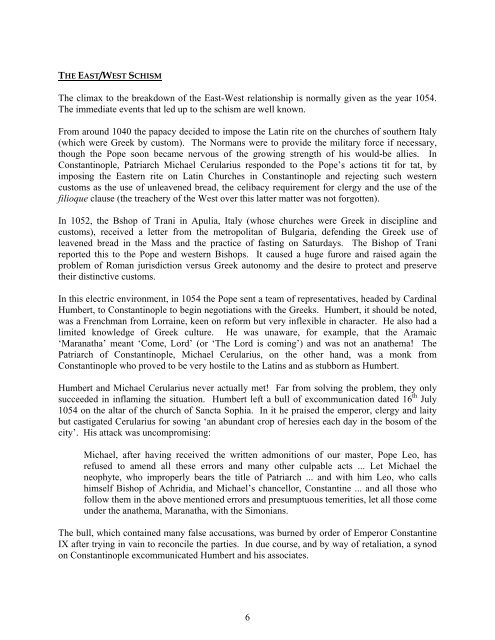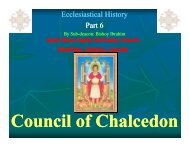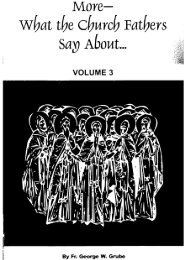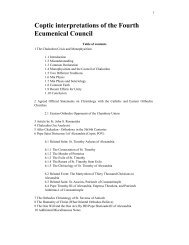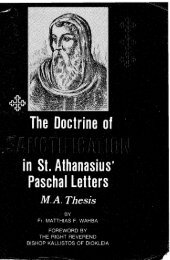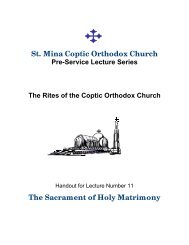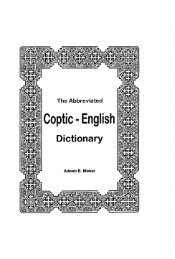Coptic Church & Ecumenical Movement - Saint Mina Coptic ...
Coptic Church & Ecumenical Movement - Saint Mina Coptic ...
Coptic Church & Ecumenical Movement - Saint Mina Coptic ...
You also want an ePaper? Increase the reach of your titles
YUMPU automatically turns print PDFs into web optimized ePapers that Google loves.
THE EAST/WEST SCHISM<br />
The climax to the breakdown of the East-West relationship is normally given as the year 1054.<br />
The immediate events that led up to the schism are well known.<br />
From around 1040 the papacy decided to impose the Latin rite on the churches of southern Italy<br />
(which were Greek by custom). The Normans were to provide the military force if necessary,<br />
though the Pope soon became nervous of the growing strength of his would-be allies. In<br />
Constantinople, Patriarch Michael Cerularius responded to the Pope’s actions tit for tat, by<br />
imposing the Eastern rite on Latin <strong>Church</strong>es in Constantinople and rejecting such western<br />
customs as the use of unleavened bread, the celibacy requirement for clergy and the use of the<br />
filioque clause (the treachery of the West over this latter matter was not forgotten).<br />
In 1052, the Bshop of Trani in Apulia, Italy (whose churches were Greek in discipline and<br />
customs), received a letter from the metropolitan of Bulgaria, defending the Greek use of<br />
leavened bread in the Mass and the practice of fasting on Saturdays. The Bishop of Trani<br />
reported this to the Pope and western Bishops. It caused a huge furore and raised again the<br />
problem of Roman jurisdiction versus Greek autonomy and the desire to protect and preserve<br />
their distinctive customs.<br />
In this electric environment, in 1054 the Pope sent a team of representatives, headed by Cardinal<br />
Humbert, to Constantinople to begin negotiations with the Greeks. Humbert, it should be noted,<br />
was a Frenchman from Lorraine, keen on reform but very inflexible in character. He also had a<br />
limited knowledge of Greek culture. He was unaware, for example, that the Aramaic<br />
‘Maranatha’ meant ‘Come, Lord’ (or ‘The Lord is coming’) and was not an anathema! The<br />
Patriarch of Constantinople, Michael Cerularius, on the other hand, was a monk from<br />
Constantinople who proved to be very hostile to the Latins and as stubborn as Humbert.<br />
Humbert and Michael Cerularius never actually met! Far from solving the problem, they only<br />
succeeded in inflaming the situation. Humbert left a bull of excommunication dated 16 th July<br />
1054 on the altar of the church of Sancta Sophia. In it he praised the emperor, clergy and laity<br />
but castigated Cerularius for sowing ‘an abundant crop of heresies each day in the bosom of the<br />
city’. His attack was uncompromising:<br />
Michael, after having received the written admonitions of our master, Pope Leo, has<br />
refused to amend all these errors and many other culpable acts ... Let Michael the<br />
neophyte, who improperly bears the title of Patriarch ... and with him Leo, who calls<br />
himself Bishop of Achridia, and Michael’s chancellor, Constantine ... and all those who<br />
follow them in the above mentioned errors and presumptuous temerities, let all those come<br />
under the anathema, Maranatha, with the Simonians.<br />
The bull, which contained many false accusations, was burned by order of Emperor Constantine<br />
IX after trying in vain to reconcile the parties. In due course, and by way of retaliation, a synod<br />
on Constantinople excommunicated Humbert and his associates.<br />
6


